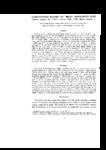| dc.identifier.citation | Maya de León, José Luis, Acosta Carreón, Aristeo y Miranda Colín, Salvador. 1969. Poliploidización inducida del híbrido intergenérico entre Triticum vulgare, Vil., Triticum durum, Desf., con Secale cereale, L. AGROCIENCIA Vol. 4. Núm. 1. 1969. pp. 17-28 | en_US |
| dc.description.abstract | El propósito de este trabajo fue el de obtener triticales a partir de trigos mexicanos y centenos adaptados a la zona del Valle del Yaqui. En el ciclo 1966-1967, se hicieron en Cd. Obregón, Son., ciento cuarenta y cuatro cruzas diferentes entre Triticum durum, Desf., Triticum vulgare, Vil., con Secale cereale, L. Esta semilla es el producto de un gameto con los cromosomas del trigo y otro con los de centeno (ABE para el caso de la cruza de trigo tetraploide con centeno, y ABDE para la F1 de trigo hexaploide por centeno), lo cual hace estériles a las plantas originadas de la mencionada semilla. En todos los casos en los que se obtuvo semilla se utilizó el trigo como madre y polen del centeno, ya que no fue posible obtener semilla de las cruzas en las que se utilizó polen de trigo en centeno. Las plántulas de 3 a 4 días de nacidas fueron tratadas con una solución de colchicina al 0.05% por medio de una técnica muy sencilla en la que se corta el hipocotilo a unos 10 mm. del punto de crecimiento y se pone en contacto con la solución. Se obtuvieron 4 líneas de triticales octaploides, lo cual dio un 1.3% de las plántulas tratadas. Es posible aumentar la eficacia del método usando una solución de colchicina al 0.1% por lo menos, y disminuyendo la distancia entre el corte del hipocotilo y el punto de crecimiento. Las líneas obtenidas pueden utilizarse como progenitores dentro de un programa de cereales que incluye a triticale como material de trabajo. ABSTRACT: The purpose of this study was to obtain "triticales" from Mexicam wheat varieties, and rye varieties adapted to El Yaqui Valley. One hundred and forty four different crosses between Triticum durum, Desf., Triticum vulgare, Vil., with Secale cereale, L were made in Ciudad Obregón, Son., during the 1967 Winter. The seed obtained is a product of a gamete with wheat cromosomes and one with rye cromosomes - ABE for the case of the cross of tetraploid wheat X rye, and ABDE for the F1 of hexaploid wheat X rye, this sterilizes the plants grown from these sedes. In all cases in which sedes were obtained, wheat plants were used as female parents. Whenever it was used wheat pollen, and rye plants as female it was imposible to obtain sedes. Seedlings - 3 to a 4 day old - were treated with a 0.05% colchicine solution by means of cutting the hypocotilus at 10 mm from the growing point and making contact with the solution. Four octaploid triticale lines were obtained, that is 1.3% of the treated plants. This percentage can be improved by using a more concentrated solution of colchicine - 0.1% al least - and shortening the distance of the cut from the growing point. The obtained lines might be used as progenitors within a program of cereal improvement, in which triticale is included as working material. | en_US |

